An Impulse Model for Computer Viruses
Abstract
Computer virus spread model concerning impulsive control strategy is proposed and analyzed. We prove that there exists a globally attractive infection-free periodic solution when the vaccination rate is larger than θ0. Moreover, we show that the system is uniformly persistent if the vaccination rate is less than θ1. Some numerical simulations are finally given to illustrate the main results.
1. Introduction
Computer virus is a kind of computer program that can replicate itself and spread from one computer to others. Viruses mainly attack the file system and worms use system vulnerability to search and attack computers. As hardware and software technology develop and computer networks become an essential tool for daily life, the computer virus starts to be a major threat. Consequently, the trial on better understanding of the computer virus propagation dynamics is an important matter for improving the safety and reliability in computer systems and networks. Similar to the biological virus, there are two ways to study this problem: microscopic and macroscopic models. Following a macroscopic approach, since [1, 2] took the first step towards modeling the spread behavior of computer virus, much effort has been done in the area of developing a mathematical model for the computer virus propagation [3–13]. These models provide a reasonable qualitative understanding of the conditions under which viruses spread much faster than others.
- (H1)
The total population of computers is divided into three groups: susceptible, infected, and recovered computers. Let S, I, and R denote the numbers of susceptible, infected and recovered computers, respectively.
- (H2)
New computers are attached to the computer network with constant rate b. For the sake of antivirus software, some new nodes have temporary immunity with probability p, some have not with probability 1 − p. Hence, new nodes are added into the susceptible class with rate (1 − p)b and into the recovered class with rate pb.
- (H3)
Computers are disconnected to the computer network with the constant rate μ and are disconnected from the attack of malicious object with probability α.
- (H4)
S computers become I with constant rate β and with constant time delay τ1; R computers become S with constant rate γ and with constant time delay τ1; I computers become R with constant rate γ.

As we know, antivirus software is a kind of computer program which can detect and eliminate known viruses. There are two common methods that an antivirus software application uses to detect viruses: using a list of virus signature definitions and using a heuristic algorithm to find viruses based on common behaviors. It has been observed that it does not always work in detecting a novel computer virus by using the heuristic algorithm. On the other hand, obviously, it is impossible for antivirus software to find new computer viruss signature definitions on the dated list. So, to keep the antivirus soft in high efficiency, it is important to ensure that it is updated. Based on the above facts, we propose an impulsive system to model the process of periodic installing or updating antivirus software on susceptible computers at fixed time for controlling the spread of computer virus.
- (H5)
The antivirus software is installed or updated at time t = kT (k ∈ N), where T is the period of the impulsive effect.
- (H6)
S computers are successfully vaccinated from S class to R class with rate θ (0 < θ < 1).
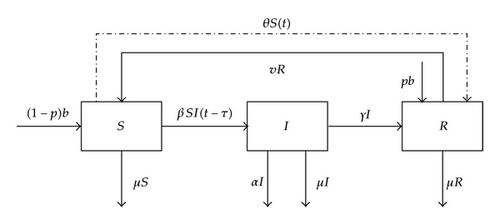
The organization of this paper is as follows. In Section 2, we first state three lemmas which are essential to our proofs and establish sufficient condition for the global attractivity of infection-free periodic solution. The sufficient condition for the permanence of the model is obtained in Section 3. Some numerical simulations are performed in Section 4. In the final section, a brief conclusion is given and some future research directions are also pointed out.
2. Global Attractivity of Infection-Free Periodic Solution
In this section, we prove that the infection-free periodic solution is globally attractive under some conditions. To prove the main results, two lemmas (given in [14]) which are essential to the proofs are stated here.
Lemma 2.1 (see [14], Lemma 1.)Consider the following impulsive system:
Lemma 2.2 (see [14], Lemma 2.)Consider the following linear neutral delay equation:
Corollary 2.3. Consider system (2.4) and assume that a1, a2, ω > 0; x(t) > 0 for −ω ≤ t ≤ 0. Then we have the following statements:
- (i)
assume that a1 < a2, then lim x→∞x(t) = 0;
- (ii)
assume that a1 > a2, then lim x→∞x(t) = +∞.
From the third and sixth equations of system (1.5), we have lim t→∞N(t) = b/μ. Further, if I(t) ≡ 0, we have the following limit system
Theorem 2.4. The infection-free periodic solution of system (1.5) is globally attractive provided that R0 < 1, where
Proof. Since R0 < 1, we can choose ε1 > 0 sufficiently small such that
From the first equation of system (1.5), we have
Corollary 2.5. The infection-free periodic solution of system (1.5) is globally attractive, if θ > θ0 where θ0 = (e(μ+ν)τ − 1)(((1 − p + ν/μ)/((μ + γ)(μ + γ + α))) − 1).
Theorem 2.4 determines the global attractivity of (1.5) in Ω for the case R0 < 1. Its realistic implication is that the infected computers vanish so the computer virus removed from the network. Corollary 2.5 implies that the computer virus will disappear if the vaccination rate is larger than θ0.
3. Permanence
In this section, we say the computer virus is local if the infectious population persists above a certain positive level for sufficiently large time. The locality viruses can be well captured and studied through the notion of permanence.
Definition 3.1. System (1.5) is said to be uniformly persistent if there is an φ > 0 (independent of the initial data) such that every solution (S(t), I(t), R(t), N(t)) with initial conditions (1.7) of system (1.5) satisfies
Definition 3.2. System (1.5) is said to be permanent if there exists a compact region Ω0 ∈ int Ω such that every solution of system (1.5) with initial data (1.7) will eventually enter and remain in region Ω0. Denote
Theorem 3.3. Suppose that R1 > 1. Then there is a positive constant mI such that each positive solution (S(t), I(t), R(t)) of system (1.5) satisfies I(t) ≥ mI, for t large enough.
Proof. Now, we will prove there exist mI > 0 and a sufficiently large tp such that I(t) ≥ mI holds for all t > tp. Suppose that for all t > t0. From the first equation of (1.5), we have
Consider the following comparison system:
Corollary 2.3 implies that t → ∞, I(t) > z3(t) → ∞. This contradicts I(t) ≤ b. Hence, we can claim that, for any t0 > 0, it is impossible that
Therefore, it is certain that there exists η (0 < η < τ, and η is independent of the choice of t2) such that
-
Case 1. If ξ ≤ η < τ, then it is obvious that , for t ∈ [t2, t2 + ξ].
-
Case 2. If η < ξ ≤ τ, then from the second equation of system (1.5), we obtain . Since , it is obvious that , for t ∈ [t2, t2 + ξ].
-
Case 3. If η < τ ≤ ξ, it is easy to obtain that for t ∈ [t2, t2 + τ]. Then, proceeding exactly the proof for above claim, we have that for t ∈ [t2 + τ, t2 + ξ].
Owing to the randomicity of t2, we obtain that there exists , such that I(t) > mI holds for all t > tp. The proof of Theorem 3.3 is completed.
Theorem 3.4. Suppose R1 > 1. Then system (1.5) is permanent.
Proof. Let (S(t), I(t), N(t)) be any solution to system (1.5). First, from the first equation of system (1.5), we have . Consider the following comparison system:
By Lemmas 2.1 and 2.2, we know that for any sufficiently small ε > 0, there exists t1 (t1 is sufficiently large) such that
4. Numerical Simulations
In this section, we perform some numerical simulations to show the geometric impression of our results. To demonstrate the global attractivity of infection-free periodic solution to system (1.5), we take the following parameter values: b = 1, μ = 0.5, γ = 0.3, α = 0.02, β = 0.3, ν = 0.7, θ = 0.4, and τ = 1. In this case, we have R0 = 0.5894 < 1. In Figures 3(a), 3(b), and 3(c) display respectively the susceptible, infected and recovered population of system (1.5) with initial conditions: S(0) = 3, I(0) = 4 and R(0) = 5. Figure 3(d) shows their corresponding phase-portrait.
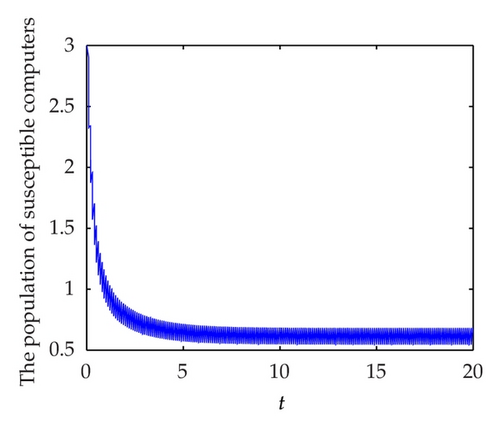
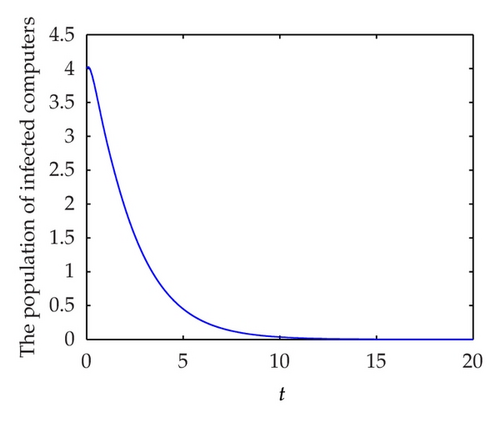
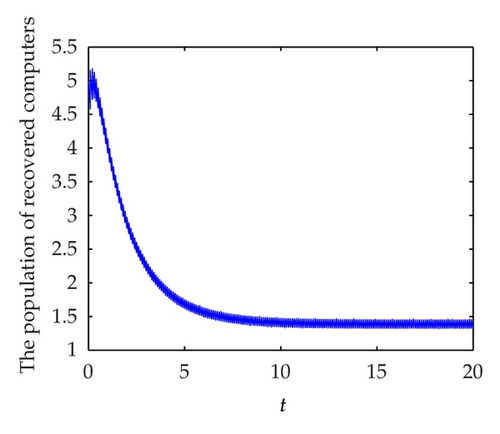
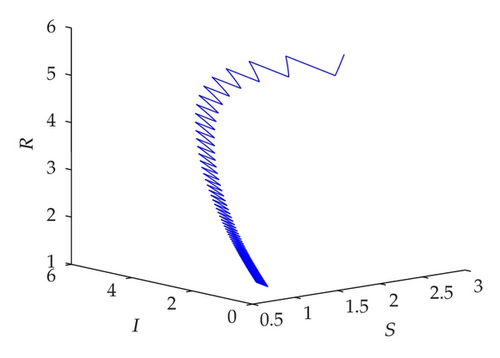
To demonstrate the permanence of system (1.5) we take following set parameter values: b = 10, μ = 0.3, γ = 0.3, α = 0.02, β = 0.3, θ = 0.2, ν = 0.7, and τ = 1. In this case, we have R1 = 2.2195 > 1. In Figures 4(a), 4(b), and 4(c) display, respectively, the susceptible, infected and recovered population of system (1.5) with initial conditions: S(0) = 3, I(0) = 4, and R(0) = 5. Figure 4(d) shows their corresponding phase portrait.
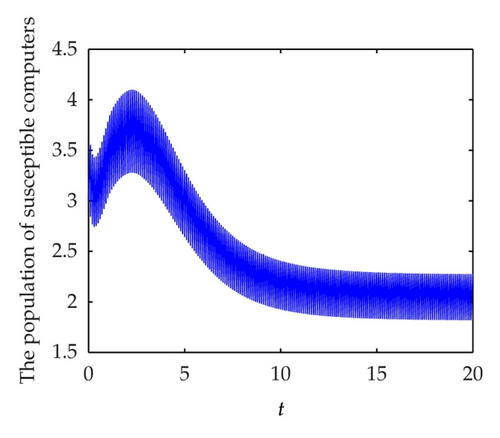
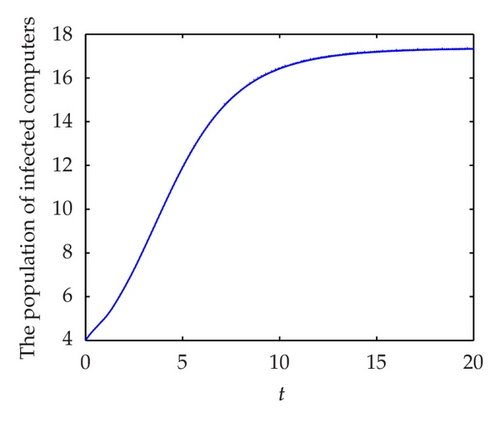
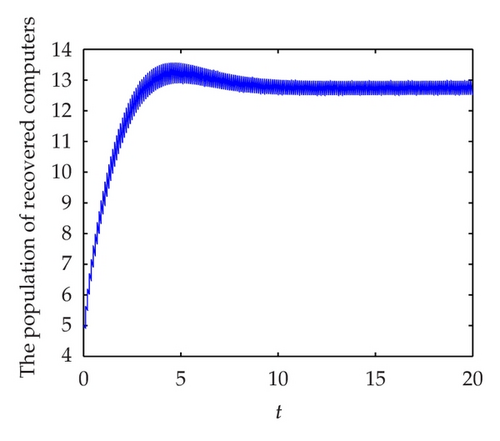
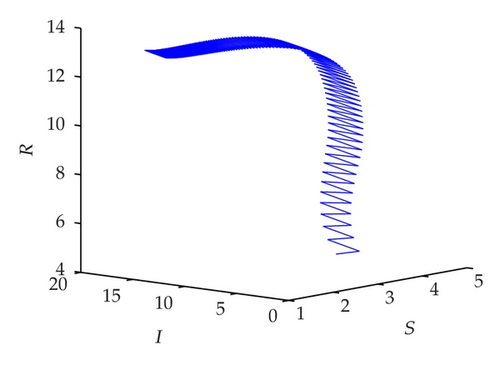
5. Conclusion
We have analyzed the delayed SIRS model with pulse vaccination and varying total population size. We have shown that R1 > 1 or θ < θ1 implies that the disease will be endemic, whereas R0 < 1 or θ > θ0 implies that the disease will fade out. We have also established sufficient condition for the permanence of the model. Our results indicate that a short interpulse time or a large pulse vaccination rate will lead to eradication of the computer virus.
In this paper, we have only discussed two cases: (i) R0 < 1 (or θ > θ0) and (ii) R1 > 1 (or θ < θ1). But for closed interval [R0, R1] (or [θ1,θ0]), the dynamical behavior of model (3) have not been studied, and the threshold parameter for the reproducing number (or the pulse vaccination rate) between the extinction of the computer viruses and the uniform persistence of the viruses have not been obtained. These issues would be left to our future consideration.
Acknowledgment
This paper is supported by the National Natural Science Foundation of China (no. 61170320), the Natural Science Foundation of Guangdong Province (no. S2011040002981) and the Scientific research Foundation of Guangdong Medical College (no. KY1048).




